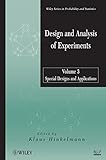Design and Analysis of Experiments . Volume 3, Special Designs and Applications / edited by Klaus Hinkelmann.
Material type: TextSeries: Wiley series in probability and statisticsPublication details: Hoboken, NJ : Wiley-Interscience, 2012.Description: 1 online resource (xxvii, 555 pages) : illustrationsContent type:
TextSeries: Wiley series in probability and statisticsPublication details: Hoboken, NJ : Wiley-Interscience, 2012.Description: 1 online resource (xxvii, 555 pages) : illustrationsContent type: - text
- computer
- online resource
- 1118147669
- 9781118147665
- 0470530685
- 9780470530689
- 9781118147634
- 1118147634
- 519.5 22
- QA279 .D47 2012eb
Includes bibliographical references and indexes.
Design and Analysis of Experiments; Contents; Preface; Contributors; CHAPTER 1: Genetic Crosses Experiments; 1.1 INTRODUCTION; 1.2 BASIC OBJECTIVES AND MODELS; 1.2.1 Generation Mean Analysis; 1.2.2 Generation Variance Analysis; 1.2.3 Covariance between Relatives; 1.2.4 Mating (M) and Environmental (E) Designs; 1.2.5 Fixed Effects and Random Effects Models; 1.3 DIALLEL MATING DESIGN OF TYPE I; 1.3.1 North Carolina Design I (NCI); 1.3.2 North Carolina Design II (NCII); 1.3.3 Sets of North Carolina Design II; 1.3.4 North Carolina Design III (NCIII); 1.3.5 Line x Tester Approach.
1.3.6 A Modified Line x Tester Approach; 1.4 DIALLEL CROSSES: TYPE II DESIGNS; 1.4.1 Hayman Approach for Diallel Analysis; 1.4.2 Griffing's Method; 1.5 PARTIAL DIALLEL CROSSES: NO BLOCKING OR COMPLETE BLOCKS; 1.6 PARTIAL DIALLEL CROSSES IN INCOMPLETE BLOCKS; 1.6.1 Construction of Mating-Environment Designs; 1.6.2 Analysis of M-E Design; 1.6.3 An Example of PDC in Incomplete Blocks; 1.6.4 Other M-E Designs; 1.7 OPTIMALITY; 1.7.1 Optimal CDC Designs for Estimation of gca; 1.7.2 Optimal Partial Diallel Crosses; 1.7.3 Estimation of Heritability; 1.8 ROBUSTNESS; 1.9 THREE- OR HIGHER-WAY CROSSES.
1.9.1 Triallel or Three-Way Crosses; 1.9.2 Double- or Four-Way Crosses; 1.10 COMPUTATION; ACKNOWLEDGMENTS; REFERENCES; CHAPTER 2: Design of Gene Expression Microarray Experiments; 2.1 INTRODUCTION; 2.2 GENE EXPRESSION MICROARRAY TECHNOLOGY; 2.2.1 Introduction; 2.2.2 Definition of a Microarray; 2.2.3 Using Microarrays to Measure Gene Expression; 2.2.4 Types of Gene Expression in Microarrays; 2.3 PREPROCESSING OF MICROARRAY FLUORESCENCE INTENSITIES; 2.3.1 Introduction; 2.3.2 Background Correction; 2.3.3 Normalization; 2.3.4 Summarization.
2.4 INTRODUCTION TO GENE EXPRESSION MICROARRAY EXPERIMENTAL DESIGN; 2.5 TWO-TREATMENT EXPERIMENTS USING TWO-COLOR MICROARRAYS; 2.6 TWO-COLOR MICROARRAY EXPERIMENTS INVOLVING MORE THAN TWO TREATMENTS; 2.7 MULTIFACTOR TWO-COLOR MICROARRAY EXPERIMENTS; 2.7.1 Introduction; 2.7.2 Admissible Designs; 2.7.3 w-Optimal Designs; 2.7.4 e-Efficiency; 2.8 PHASE 2 DESIGNS FOR COMPLEX PHASE 1 DESIGNS; REFERENCES; CHAPTER 3: Spatial Analysis of Agricultural Field Experiments; 3.1 INTRODUCTION; 3.2 METHODS TO ACCOUNT FOR SPATIAL VARIATION; 3.2.1 Design of Experiments; 3.2.2 Spatial Analysis Methods.
3.3 A SPATIAL LINEAR MIXED MODEL; 3.3.1 Estimation, Prediction and Testing; 3.3.2 The Spatial Modeling Process; 3.4 ANALYSIS OF EXAMPLES; 3.4.1 Herbicide Tolerance Trial; 3.4.2 Variety Trial; REFERENCES; CHAPTER 4: Optimal Designs for Generalized Linear Models; 4.1 INTRODUCTION; 4.2 NOTATION AND BASIC CONCEPTS; 4.2.1 Binary Data; 4.2.2 Count Data; 4.2.3 Optimality Criteria; 4.3 TOOLS FOR FINDING LOCALLY OPTIMAL DESIGNS; 4.3.1 Traditional Approaches; 4.3.2 An Analytical Approach; 4.4 GLMs WITH TWO PARAMETERS; 4.5 GLMs WITH MULTIPLE PARAMETERS; 4.5.1 GLMs with Multiple Covariates.
4.5.2 GLMs with Group Effects.
This book discusses special modifications and extensions of designs that arise in certain fields of application such as genetics, bioinformatics, agriculture, medicine, manufacturing, marketing, etc. Well-known and highly-regarded contributors have written individual chapters that have been extensively reviewed by the Editor to ensure that each individual contribution relates to material found in Volumes 1 and 2 of this book series. The chapters in Volume 3 have an introductory/historical component and proceed to a more advanced technical level to discuss the latest results and future development.
There are no comments on this title.


